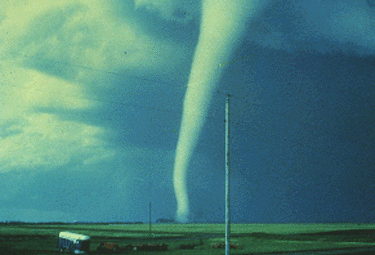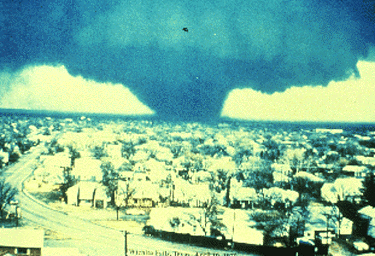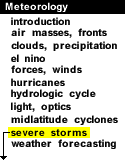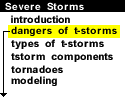
|
The last severe weather element is the tornado. Defined as a violently rotating column of air in contact with the ground and pendent from a cumulonimbus cloud, tornadoes are capable of inflicting extreme damage.

Photograph by: Marshall
They can be categorized as "weak", "strong", and "violent"; with weak tornadoes often having a thin, rope-like appearance, as exhibited by this tornado near Dawn, Texas (looking west from about 1 mile). About 7 in 10 tornadoes are weak, with rotating wind speeds no greater than about 110 MPH.
The typical strong tornado often has what is popularly considered a more "classic" funnel-shaped cloud associated with the whirling updraft. Rotating wind speeds vary from 110 to 200 MPH.

Photograph by: NSSL
Nearly 3 in 10 tornadoes are strong, such as this twister on the plains of North Dakota. Looking northeast, note the spiraling inflow cloud, probably a tail cloud, feeding into the tornado. An important safety consideration is that weak and strong tornadoes, by definition, do not level well-built homes. Thus, a secure home will offer shelter from almost 100 percent of all direct tornado strikes.
Only violent tornadoes are capable of leveling a well-anchored, solidly constructed home. Fortunately, less than 2 percent of all tornadoes reach the 200+ MPH violent category. Furthermore, most violent tornadoes only produce home-leveling damage within a very small portion of their overall damage swath. Less than 5 percent of the 5,000 affected homes in Wichita Falls, Texas were leveled by this massive 1979 tornado. (Looking south from about 5 miles).

Photograph by: IDR
Note the huge, circular wall cloud above the tornado. This feature is probably close both in size and location to the parent rotating updraft (called a mesocyclone) which has spawned the violent tornado. Strong and violent tornadoes are usually associated with storms containing mesocyclones.

downbursts |
|

Types of T-storms |




